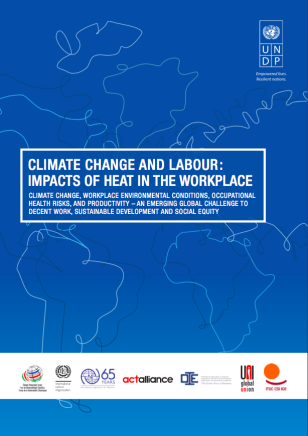Climate Change and Labor: Impacts of Heat in the Workplace

English
DownloadClimate Change and Labor: Impacts of Heat in the Workplace
April 28, 2016
Developed in collaboration with the ILO, the International Organization for Migration, UNI Global Union, the International Trade Union Confederation, the International Organization of Employers, and ACT Alliance, and together with the Climate Vulnerable Forum and the support of the the World Health Organisation, this report looks at the impact of rising temperatures due to climate change on the workforce.
Rising heat in the workplace implies severe effects for Least Developed Countries, Small Island Developing States (SIDS) and emerging economies with high concentrations of outdoor labour and industrial and service sector workers operating in ineffectively climate controlled conditions. Its consequences imply effects for a majority of the Sustainable Development Goals (SDGs), including poverty (SDG1) and hunger (2), health (3), education (4), gender (5) and income inequalities (10), good jobs and growth (8), and sustainable cities and communities (11).
As detailed in the report: “When it is too hot, people work less effectively out-of-doors, in factories, the office or on the move due to diminished ability for physical exertion and for completing mental tasks. Heat extremes also increase accident risk and expose people to serious heat-related health risks including heat stroke, severe dehydration and exhaustion, while a body temperature above 40.6º Celsius is life-threatening. That is why governments and international organizations have long put in place standards on thermal conditions in the workplace. But climate change has already altered thermal conditions in the work place, and additional warming is a serious challenge for any worker or employer reliant on outdoor or non-air conditioned work,” moreover “Levels of heat in many tropical locations are already very high with respect to thermal tolerances even for acclimatized populations.”

 Locations
Locations




